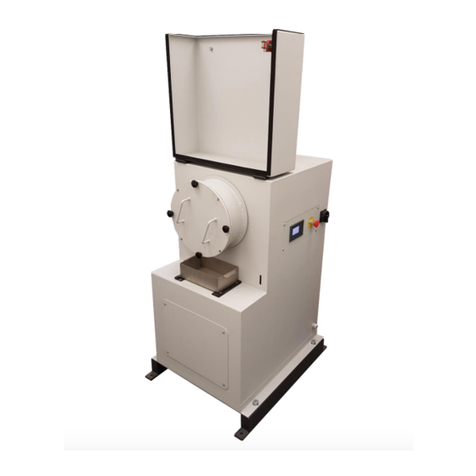08.02.2012 Retsch GmbH 2 0002
NOTES ON THESE OPERATING INSTRUCTIONS.......... 3
Warning instructions ................................................................ 3
Repairs........................................................................................ 3
SAFETY...................................................................................... 4
Safety instructions.................................................................... 4
Safety instructions –summarised, part 1 ............................ 5
Safety instructions –summarised, part 2 ............................ 6
Confirmation.............................................................................. 7
TECHNICAL DATA .................................................................. 8
Use according to the intended purpose ................................ 8
Number of milling positions .................................................... 8
Maximum charged quantity .................................................... 8
Maximum charged grain size.................................................. 8
Driving power: 1500 W............................................................ 8
Emissions ................................................................................... 8
Noise characteristic values PM400 :...................................... 8
Conditions for measurement:................................................. 8
Materials and analyses of milling tools ................................. 8
Systems of protection .............................................................. 8
Protective equipment ............................................................... 9
Mode of operation..................................................................... 9
Machine dimensions ................................................................. 9
Required floor space................................................................. 9
TRANSPORT AND INSTALLATION.................................. 10
Packing ..................................................................................... 10
Transport.................................................................................. 10
Temperature variations ......................................................... 11
Intermediate storage ............................................................. 11
Assembling............................................................................... 11
Parameters for the place of installation .............................. 11
Ambient temperature: ............................................................11
Installation height:..................................................................11
Serial interfaces ...................................................................... 12
OPERATION ........................................................................... 13
Connecting the power supply ............................................... 13
Opening / closing / emergency unlocking of milling
chamber ................................................................................... 13
Open ..........................................................................................13
Closing ...................................................................................... 13
Emergency unlocking ............................................................. 14
Insertion and clamping of the milling cups......................... 14
Unclamping the milling cup clamping device ..................... 16
in the PM400............................................................................ 16
Safety instructions when starting the PM400..................... 17
Power failure during milling................................................... 18
Suitable milling cups in the PM400 ...................................... 18
Milling cup filling level ............................................................ 18
Guide values for material quantity and balls...................... 18
Stacking of 50 ml milling cups of type “C” ......................... 19
Stacking procedure................................................................. 19
Stacking of milling cups less than 50 ml............................. 19
Stacking procedure................................................................. 19
Handling milling cups of type “C”......................................... 19
Carrying and gripping............................................................. 19
Protection against twisting .................................................... 19
Heating up of the milling cups.............................................. 19
Milling cup identification ........................................................ 20
Milling cup labelling by the customer .................................. 20
Cleaning the milling cups....................................................... 20
Drying the milling cups.......................................................... 20
Tips for ultra-fine milling ....................................................... 20
Use of the closing device for milling cups........................... 21
Operation via the display unit of the PM400 ...................... 22
Symbols in the display unit ................................................... 22
Setting possibilities via the display menu........................... 23
FAULT SIGNALS IN THE DISPLAY.................................. 28
F03 to F23 ................................................................................ 28
F24 to F26 ................................................................................ 28
GENERAL................................................................................. 29
Cleaning.................................................................................... 29
Maintenance (monthly).......................................................... 29
Wearing parts .......................................................................... 30
Copyright.................................................................................. 30
Alterations................................................................................ 30
APPENDIX ..................................FOLLOWING PAGES




























